A scarred back goes rigid. Bruised legs go stiff. Blood-shot eyes roll back in their sockets. Ripped ears pin backward and lay against the skull. A snort-wheeze breaks the silence as he reaches his opponent. A battle-scarred buck lowers his head and plows the decoy right in front of your face. Those are the sights you see when decoying whitetails during the rut. And Phillip Vanderpool, a host for The Virtue, is ready to hash out the fine print. Here are his top 10 pieces of advice when duping rut-crazed bucks with the dekes.
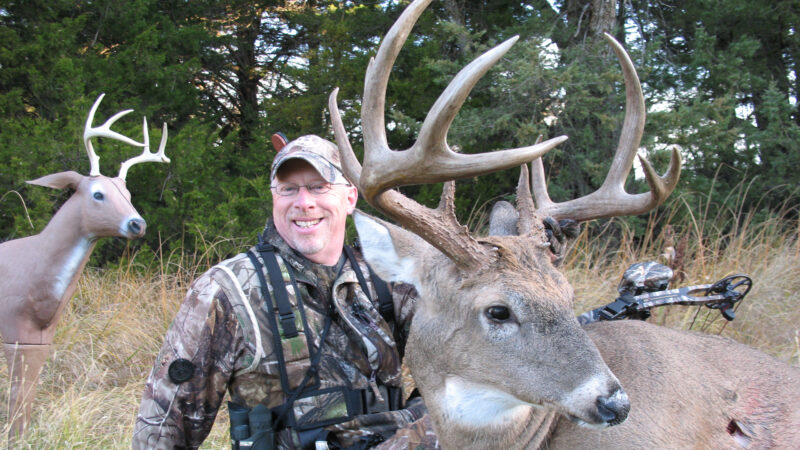
Cautious Scent Control
Scent control is the No. 1 rule when decoying. It is imperative to wear both rubber gloves and rubber boots when setting up the decoy. Keep in mind that Scent-A-Way is the best way to minimize scent once in the field. Spray both yourself and the decoy thoroughly in order to kill any human odor. Keep in mind that the wind often shifts during that last half hour of daylight.
“They will want to come in downwind. Make sure there isn’t any scent left behind for them to detect,” Vanderpool said.
One way to minimize both scent and noise is to pack in the decoy ahead of time and leave it close to where you will be deploying it. Keep it concealed so that it doesn’t spook any deer while you are away. This reduces both scent and noise while increasing your odds of bagging that buck of a lifetime.
Makes Sense to Use Scents
Scents can play a key role in decoying. Remember, he’s going to come in downwind. You do not want him to smell nothing at all, just not human odor. However, it wouldn’t be right (and he will know it) if he doesn’t smell typical whitetail aromas.
“Use doe urine on the head of the buck. Place dominant buck scent on the back legs, around the hocks and on the ground around its feet,” Vanderpool said.
This combination of scents will make it more realistic when that deer comes stomping in to your decoy set. It pays to have every advantage possible. Up the odds by adding a little stink to the deke.
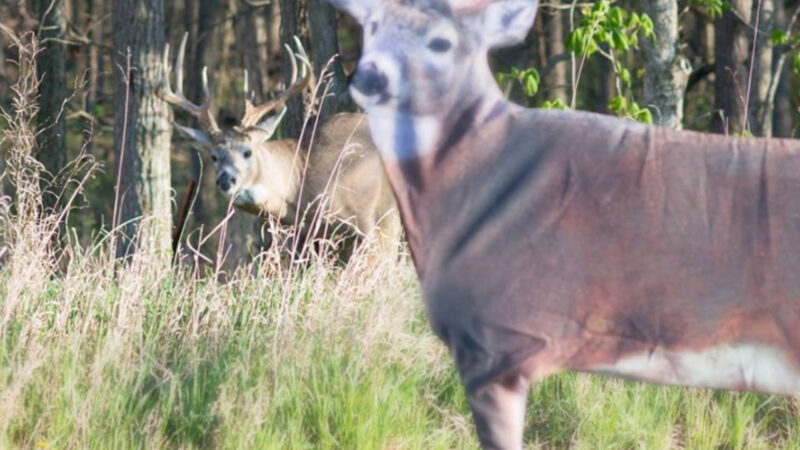
Calling in Conjunction
Calling can be a great supplement to add realism to your decoy. By doing so you add another element to your setup – sound. You already have both sight and smell. Adding vocalizations might just prove enough to draw that buck in when without it, he would have been reluctant to do so.
“Use rattling, grunts, and snort-wheezes in conjunction with your decoying. It makes it even more realistic when that buck rounds the bend and sees the intruder that has invaded his territory,” Vanderpool said.
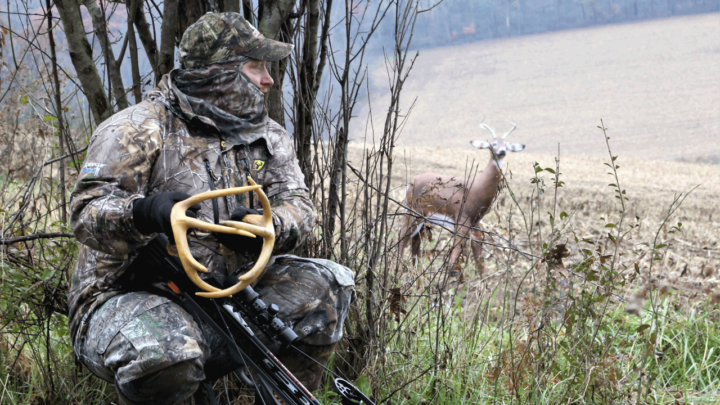
Visibility –The X Factor
Visibility is extremely important when trying to entice a buck into range with a decoy. The only way to ensure that a buck sees it, is to make sure that you put it in a place that he can. In other words, don’t decoy in tight places.
“The main ingredient in decoying is visibility. I have found it unproductive to decoy in tight areas where visibility is limited. Bucks can’t see the decoy as well in such areas. And when they do, they always seem to be hesitant about committing. If you want to deploy a decoy, do it in the open. Positioning is everything,” Vanderpool said.
Be Open About It
“I like to decoy in open fields, but every now and then, I like to decoy in timber as well. If doing so, it must be open timber. Very open timber. It coincides with visibility. A buck likes to be able to see his opponent from a distance before closing in for a confrontation,” Vanderpool said.
Keep in mind where the deer will likely be coming from. Place the decoy in the open where it will draw the deer past you. Make it obvious. The objective is not to surprise them. But to allow them to see it from a distance so they can get worked up as they close the gap.
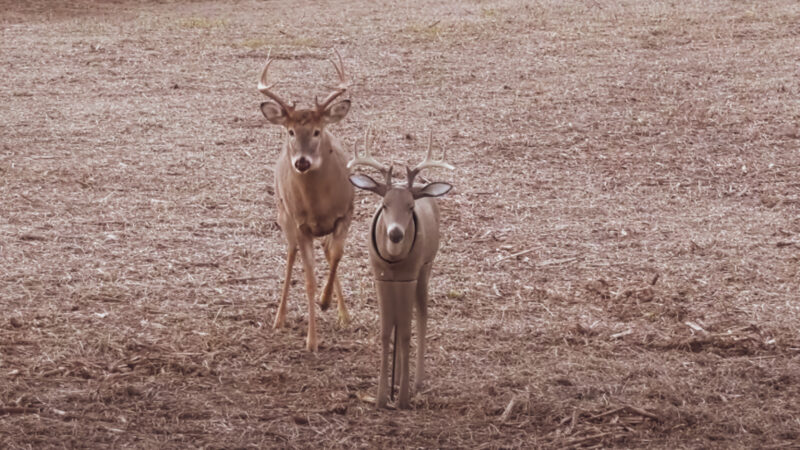
Provide an Escape Route
Don’t forget to leave a 360-degree buffer zone. What does that mean? It means allow that buck room to “get away” should that lifeless decoy whip his tail. A buck might not engage a fight if he doesn’t see a plan B or a way to get out of town should he lose the fight.
“Keep a 360-degree circle all the way around your setup. A deer needs a way to escape if he comes out on the losing end,” Vanderpool said.
This is where some hunters go wrong. They will place the buck with its back right up against a wall of vegetation and foliage expecting a deer to come maul it. Sometimes they might do just that. Even so, you will see better results (and more frequent results) by allowing an escape route in every direction.
Read Between the Signs
Body language is extremely important when decoying whitetails. It is imperative that a hunter is ready to read a buck and know what he is going to do … before he does it. Keep in mind that not every buck will react the same way to a decoy. They are much like humans in one aspect – they all have their own tendencies.
“If a buck is acting nervous and is sub-dominant, hold low on the vitals. You don’t want him jumping the string. If he comes waltzing in all bristled up and ready to fight, hold right on. He is focused on the decoy and probably won’t react much to the shot,” Vanderpool said.
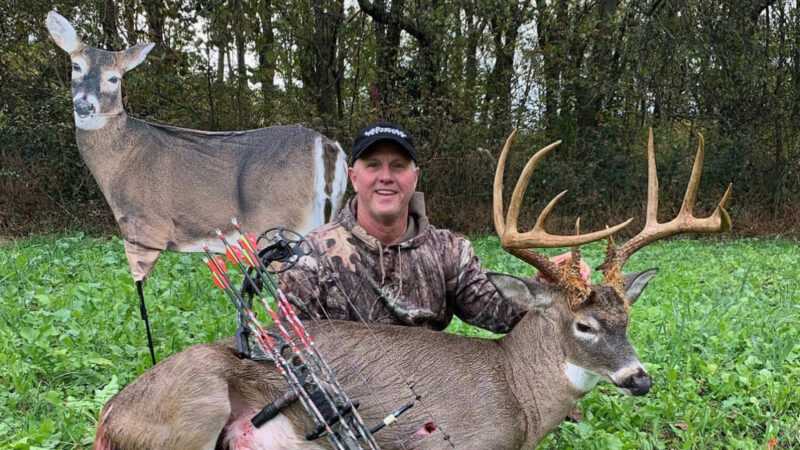
Significance of a Stand Site
This pretty much goes without saying, but stand placement (or ground blind location) is very important. Make sure the area you want to decoy in has adequate sources to hang a stand or resources to brush in a blind. If it does not, choose another spot.
“Hunting with a decoy can be tough. Everything must play together for it to work out. Stand location is not something to overlook when trying to lure in a mature deer,” Vanderpool said.
Also keep in mind typical wind patterns, travel routes, and the location of the sun in the sky. If the circumstances allow, you want the sun at your back. That’s not always possible. However, it is much to your advantage when it is.
Patience, Patience, Patience
Patience is most folks’ Achilles heel. You must be patient when trying to dupe a whitetail over a decoy. It isn’t going to happen every time you go into the field. But when it does, look out; it’s going to be a wild ride.
“A lot of people set up wrong for the wind where bucks do not feel safe to begin with. That’s their first mistake. A lot of people give up too early and don’t give it time to work. It’s not magic. It won’t always work. But when your heart is racing and you see it happen, emotions run off the charts,” Vanderpool said.
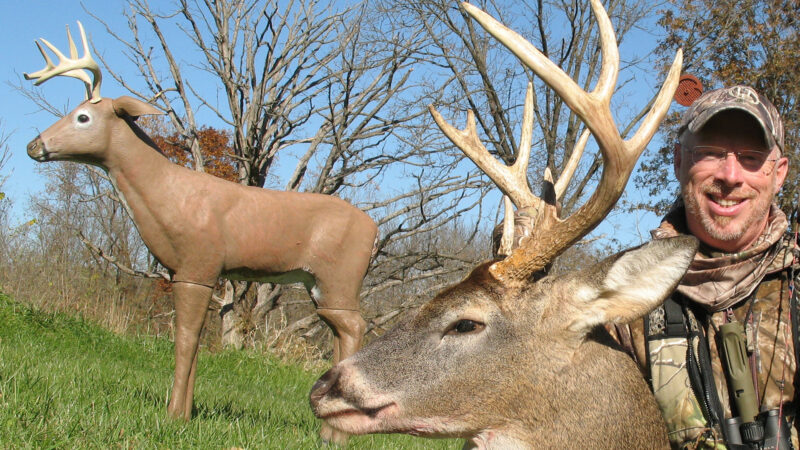
Last Chance – The Buck Stops Here
Sometimes when decoying, you don’t get to take the shot before the oncoming whitetail demolishes your decoy. That isn’t always a bad thing. More times than not, two things will happen. First, the buck will crush the decoy. Secondly, due to his confusion, he will bolt five to 10 yards before stopping to turn and look at what happened. This is your opportunity to shoot.
“If he kills the decoy and spooks, get ready. Nine times out of ten times, he will run a few yards before stopping to turn and look. Draw your bow just as he hits the decoy. When he stops, it will likely be a quartering-away shot. Take the shot now. It won’t be a very big window. You will have to take the shot just as he stops to turn and look,” Vanderpool said.
Sometimes a buck will not stop, even if you do grunt at him. The only thing to do is let him hit the decoy. If that happens, you will have to let him stop on his own. It is confusing for bucks to see the fight end so quickly. That’s why they stop and turn to look. As the old cliché goes, “curiosity killed the cat.” Except, in this case, it killed the buck.
Decoying Right
The most effective time to decoy is during the seeking phase of the rut (Usually the last 7-10 days in Oct into early Nov). This is when all the big boys are up on their feet looking for that first estrous doe. Seeing a big buck invade their space that they aren’t familiar with, well, let’s just say it might provoke a fight.
One thing we haven’t discussed that is very important to successfully decoying a whitetail during this very tense period of the rut, is placement of the decoy in terms of direction. In most cases, if the situation allows, you want to place the decoy facing downwind. Furthermore, you want it quartering slightly toward your position.
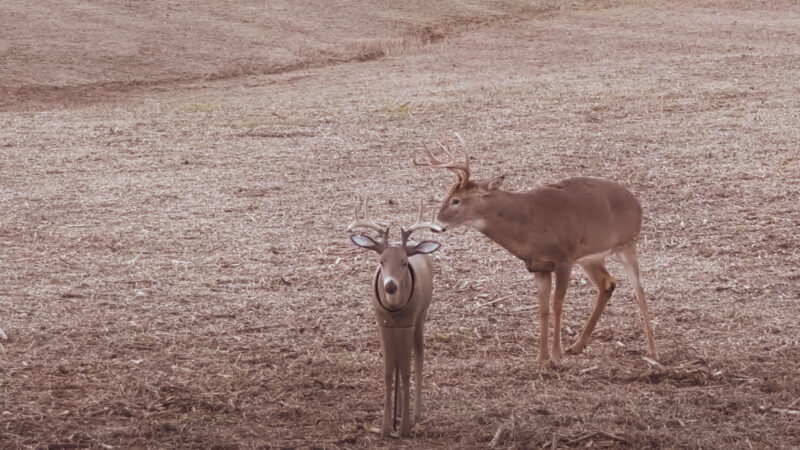
Most bucks will want to get the wind in their favor before committing to the decoy. If they are dominant, they will come in head on. If not, they will likely approach the decoy from the rear. Most of the time, if they do come in, they will be dominant. By having the decoy quartering slightly toward the hunter, it provides the desired quartering-away shot when the buck comes in face-to-face with the intruder decoy.
Keep the decoy within 20 yards of your location. Any further than that will be too far. A good range is between 15 and 20 paces. If a buck hangs up and the decoy is any further than this, you will probably not get a shot.
When it is all said and done, decoying is the tactic for you if you like high-impact styles of hunting. If you do everything right and keep in mind each factor – such as decoy placement – then this tactic could very well be your ace card. It keeps the deer’s attention off you and lures them in close. When without it, they may not have came in otherwise.

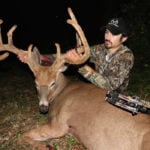 By
By 



